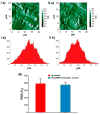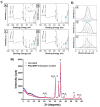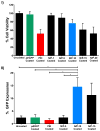Gene-Activated Titanium Surfaces Promote In Vitro Osteogenesis
- PMID: 27706263
- PMCID: PMC5350041
- DOI: 10.11607/jomi.5026
Gene-Activated Titanium Surfaces Promote In Vitro Osteogenesis
Abstract
Purpose: Commercially pure titanium (CpTi) and its alloys possess favorable mechanical and biologic properties for use as implants in orthopedics and dentistry. However, failures in osseointegration still exist and are common in select individuals with risk factors such as smoking. Therefore, in this study, a proposal was made to enhance the potential for osseointegration of CpTi discs by coating their surfaces with nanoplexes comprising polyethylenimine (PEI) and plasmid DNA (pDNA) encoding bone morphogenetic protein-2 (pBMP-2).
Materials and methods: The nanoplexes were characterized for size and surface charge with a range of N/P ratios (the molar ratio of amine groups of PEI to phosphate groups in pDNA backbone). CpTi discs were surface characterized for morphology and composition before and after nanoplex coating using scanning electron microscopy (SEM), atomic force microscopy (AFM), X-ray photoelectron spectroscopy (XPS), and X-ray powder diffraction (XRD). The cytotoxicity and transfection ability of CpTi discs coated with nanoplexes of varying N/P ratios in human bone marrow-derived mesenchymal stem cells (BMSCs) was measured via MTS assays and flow cytometry, respectively.
Results: The CpTi discs coated with nanoplexes prepared at an N/P ratio of 10 (N/P-10) were considered optimal, resulting in 75% cell viability and 14% transfection efficiency. Enzyme-linked immunosorbent assay results demonstrated a significant enhancement in BMP-2 protein secretion by BMSCs 7 days posttreatment with PEI/pBMP-2 nanoplexes (N/P-10) compared to the controls, and real-time PCR data demonstrated that the BMSCs treated with PEI/pBMP-2 nanoplex-coated CpTi discs resulted in an enhancement of Runx-2, alkaline phosphatase, and osteocalcin gene expressions on day 7 posttreatment. In addition, these BMSCs demonstrated enhanced calcium deposition on day 30 posttreatment as determined by qualitative (alizarin red staining) and quantitative (atomic absorption spectroscopy) assays.
Conclusion: It can be concluded that PEI/pBMP-2 nanoplex (N/P-10)-coated CpTi discs have the potential to induce osteogenesis and enhance osseointegration.
Figures







References
-
- Yamaguchi A. Regulation of differentiation pathway of skeletal mesenchymal cells in cell lines by transforming growth factor-beta superfamily. Semin Cell Biol. 1995;6:165–173. - PubMed
-
- Heldin CH, Miyazono K, tenDijke P. TGF-beta signalling from cell membrane to nucleus through SMAD proteins. Nature. 1997;390:465–471. - PubMed
-
- Wegman F, Bijenhof A, Schuijff L, Oner FC, Dhert WJA, Alblas J. Osteogenic Differentiation as a Result of Bmp-2 Plasmid DNA Based Gene Therapy in Vitro and in Vivo. Eur Cells Mater. 2011;21:230–242. - PubMed
-
- Poynton AR, Lane JM. Safety profile for the clinical use of bone morphogenetic proteins in the spine. Spine. 2002;27:S40–S48. - PubMed
MeSH terms
Substances
Grants and funding
LinkOut - more resources
Full Text Sources
Other Literature Sources
Miscellaneous

